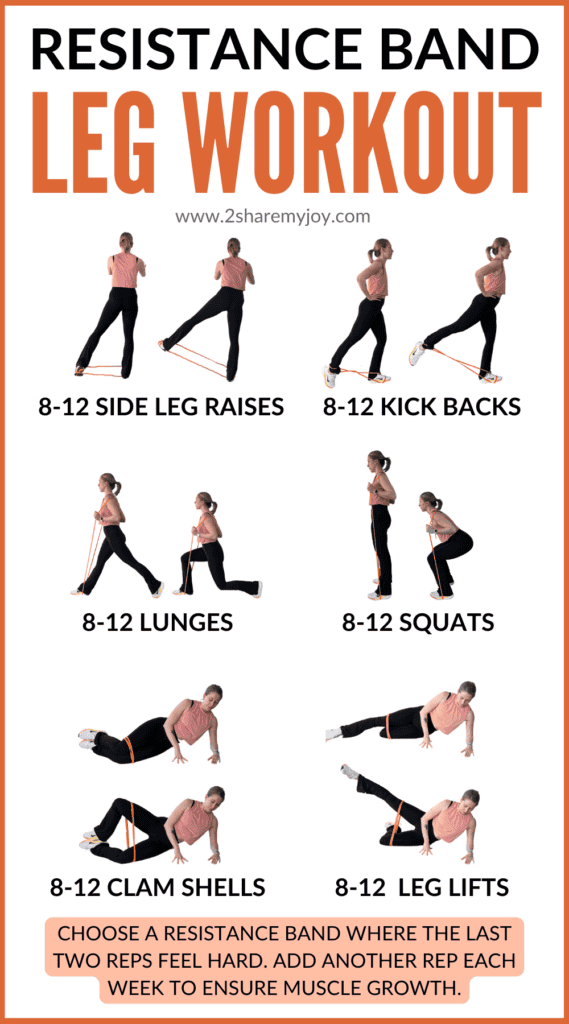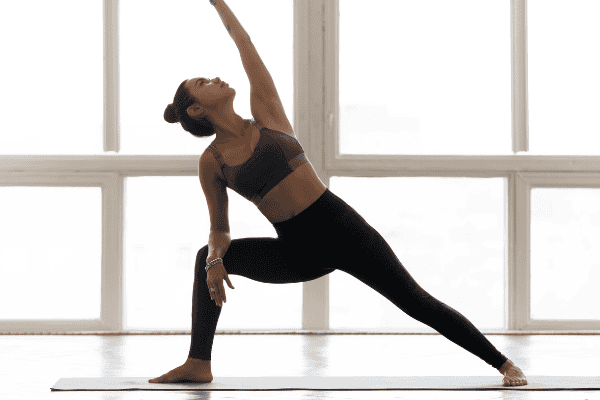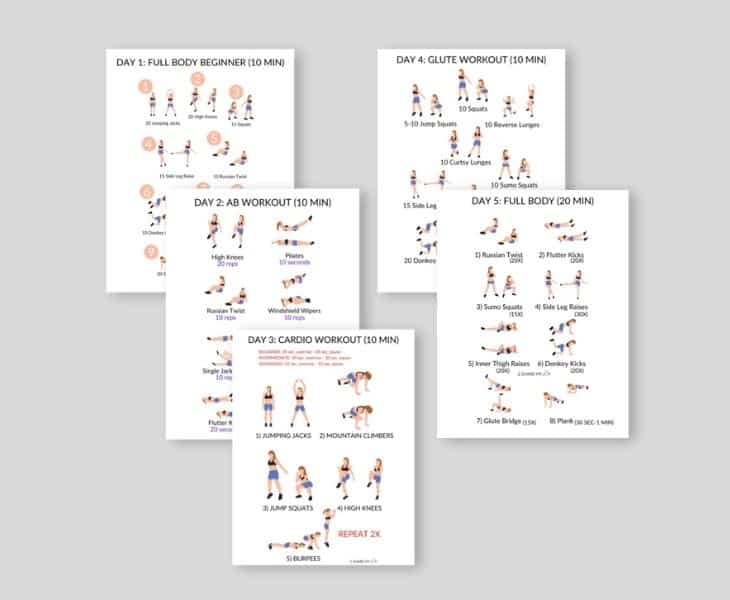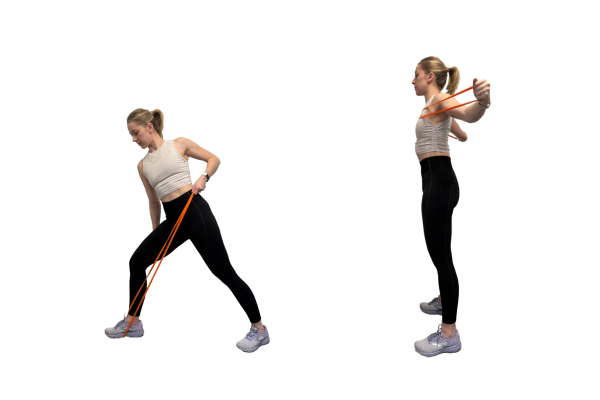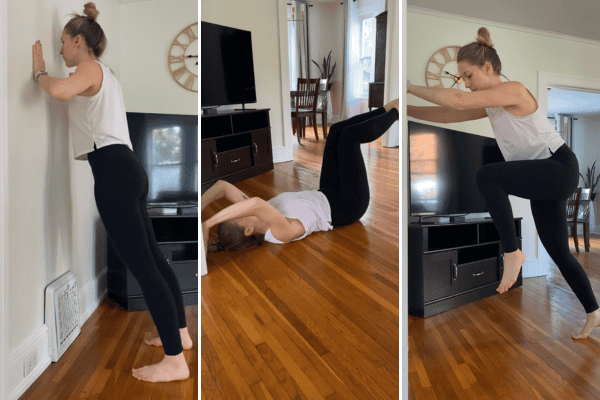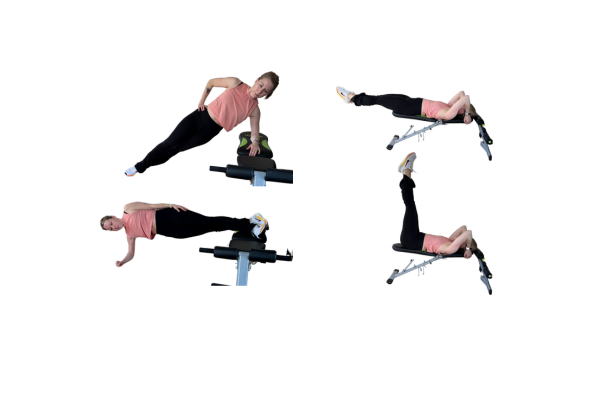Resistance Band Leg Workout
Here is the best resistance band leg workout you can do at home or in the gym. It is beginner friendly, yet still builds strong leg muscles.
How to Choose the Right Resistance Band
Choosing the right type of resistance band is crucial. You’ll come across loop bands and bands with handles, each serving different purposes to enhance your fitness routine.
Loop bands, for instance, are perfect for exercises like resistance band squats, clamshells, and lateral band walks, seamlessly incorporating into your leg muscles and gluteal muscles strengthening exercises. On the other hand, bands with handles can be ideal for more dynamic movements, offering an extra challenge to your lower body workout.
I prefer the longer loop resistance bands (not the mini bands) as they are more versatile. You can use them with an anchor and have more resistance options. They are also less prone to tearing off the handle.
Whether you’re engaging in a home workout or integrating resistance bands into your gym session, selecting a band that matches your fitness level and the specific resistance band exercises you plan to perform ensures an effective and safe strengthening of your leg muscles and gluteal muscles, even offering knee pain prevention.
Do 8-12 reps for each exercise. The last 2 reps should feel challenging. That’s a good resistance. Each exercise may require a different resistance strength, so having sets with light, medium, and hard resistance levels is a good start. There are also more advanced sets available online.
To ensure that you build muscle effectively, you need to increase the intensity each week, whether that means adding another rep or moving up to the next resistance level.
Journaling reps, band color/intensity, sets, and resistance levels is crucial for progressive overload.
More Resistance Band Workouts:
- Resistance Band Glute Workout
- Resistance Band Core Workout
- Resistance Band Back Workout
- Resistance Band Arm Workout
7 Best Resistance Band Leg Exercises
With exercises like resistance band squats, clamshell exercise, and lateral band walk, among others, you’re not only fortifying your leg muscles and gluteal muscles but also improving muscle recruitment, crucial for achieving that toned appearance.
Whether you’re at home or in the gym, incorporating these resistance band exercises into your workout regimen promises a path toward stronger, more defined legs and glutes.
So, let’s delve into the seven best resistance band exercises that are poised to maximize your leg day.
#1 Resistance Band Clamshell
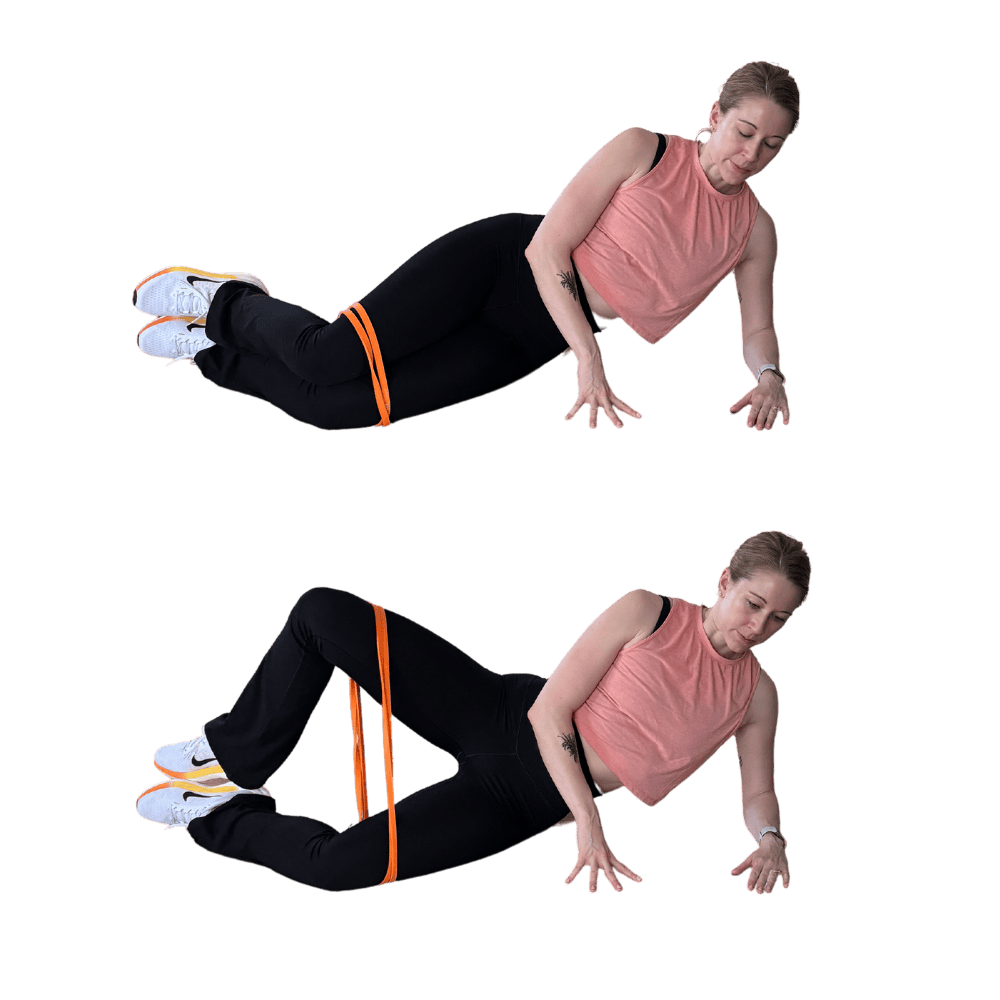
- Loop the resistance band just above your knees, lying on your side with hips and knees stacked.
- As you engage your core, lift your upper knee as high as you can without shifting your hips. You’re targeting the gluteus medius here, crucial for muscle tone and leg stability.
- To adjust the intensity, simply switch out your band for one with more or less resistance or adjust the band’s position.
- Remember, the key to maximizing the benefits of this lower body workout and avoiding any potential injury is all in sticking to the correct form.
- Just like with any resistance training or fitness bands routine, listen to your body and gradually increase the challenge as your muscles grow stronger.
#2 Resistance Band Squats
If you’re looking to elevate your leg workout, incorporating resistance band squats can significantly enhance muscle activation, particularly in your gluteal muscles.
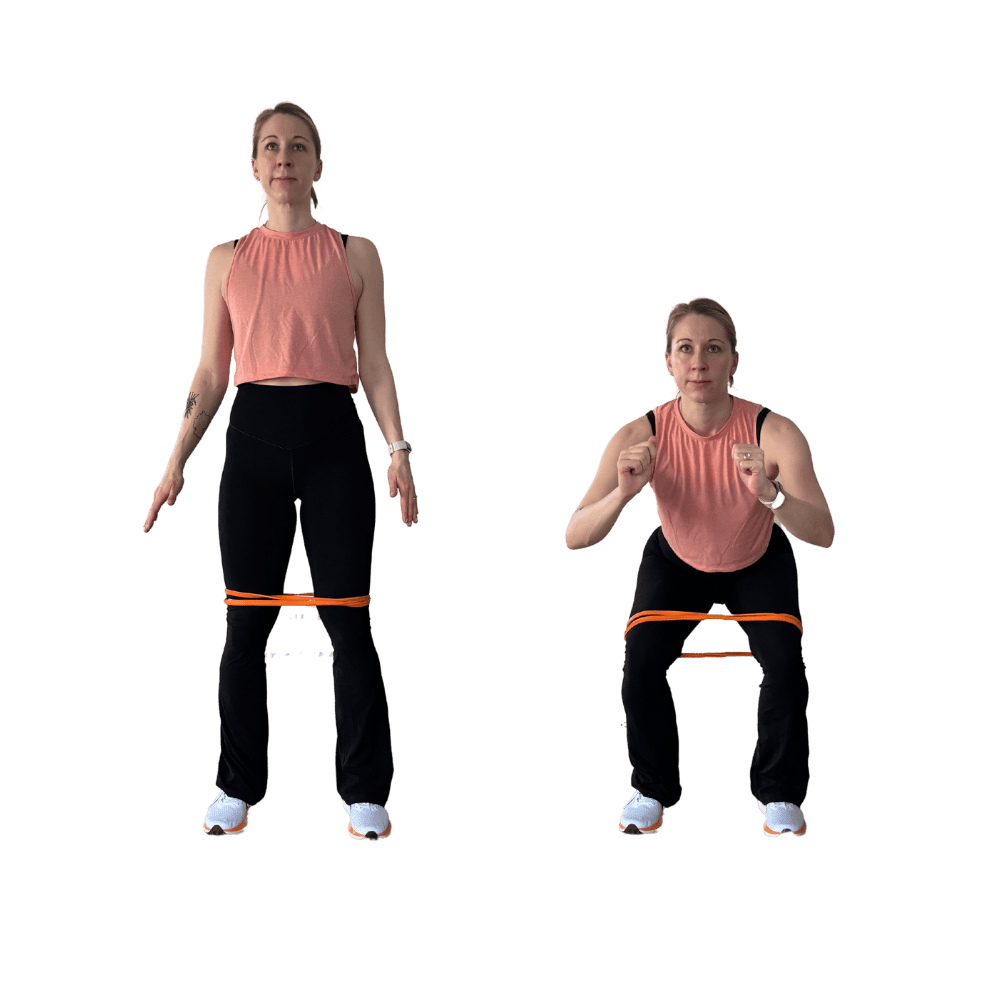
- Place a resistance band around your thighs, just above your knees. This slight addition applies more tension, requiring your leg muscles to work harder, especially when moving in and out of the squat position.
- Standing with your feet hip-width apart, lower your body as if sitting back into a chair. Ensuring the band doesn’t slacken, push your knees outward against its resistance.
- This added challenge not only strengthens but also improves the form of your bodyweight squats.
For those new to resistance training or experiencing knee pain, modifications can make this exercise more accessible. Try performing the squat without going as low, which reduces strain on the knees while still engaging the lower body workout effectively.
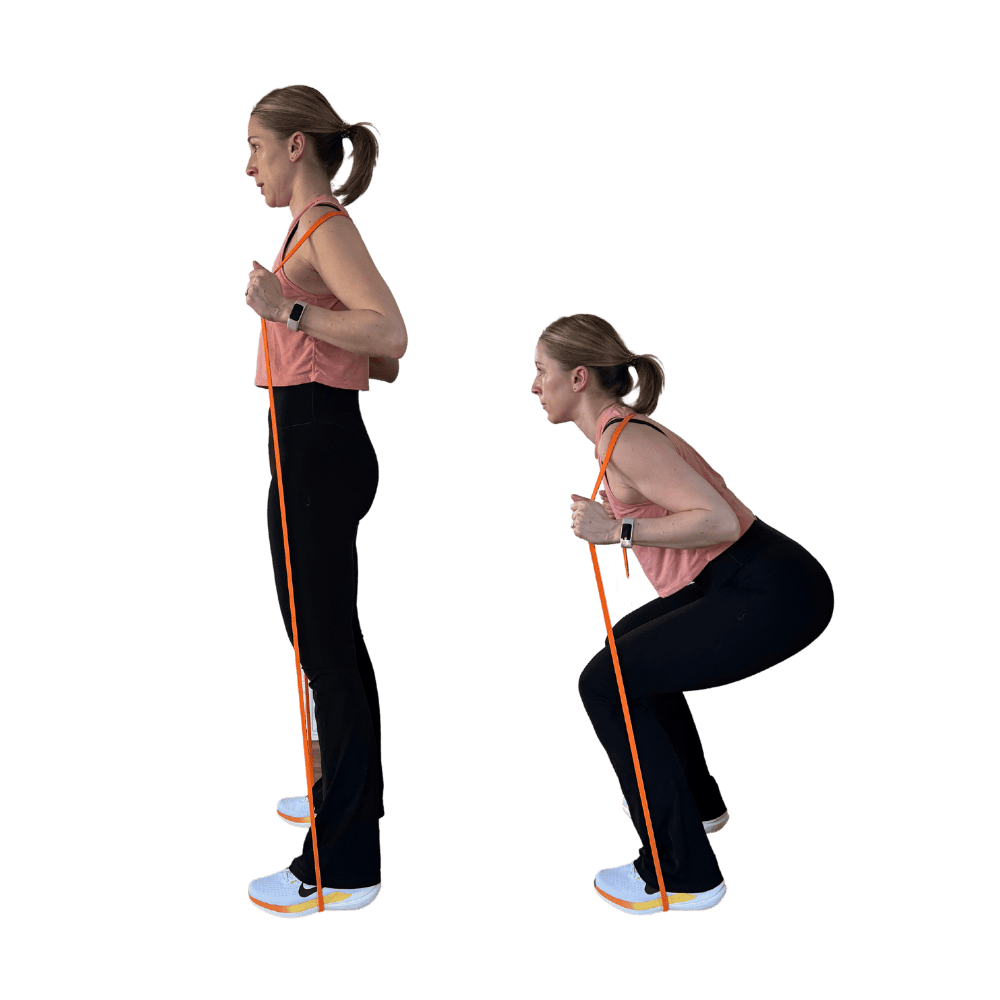
Another option is to wrap the band around your feet and shoulders, holding it in place with your hands. This will give you more resistance to the upward push.
By incorporating resistance band squats into your fitness routine, you’re not just working your leg muscles but also stepping up your home workout with simple yet effective workout equipment. This is an excellent method for those looking to increase muscle tone and strength in their lower body.
#3 Resistance Band Side Leg Raises
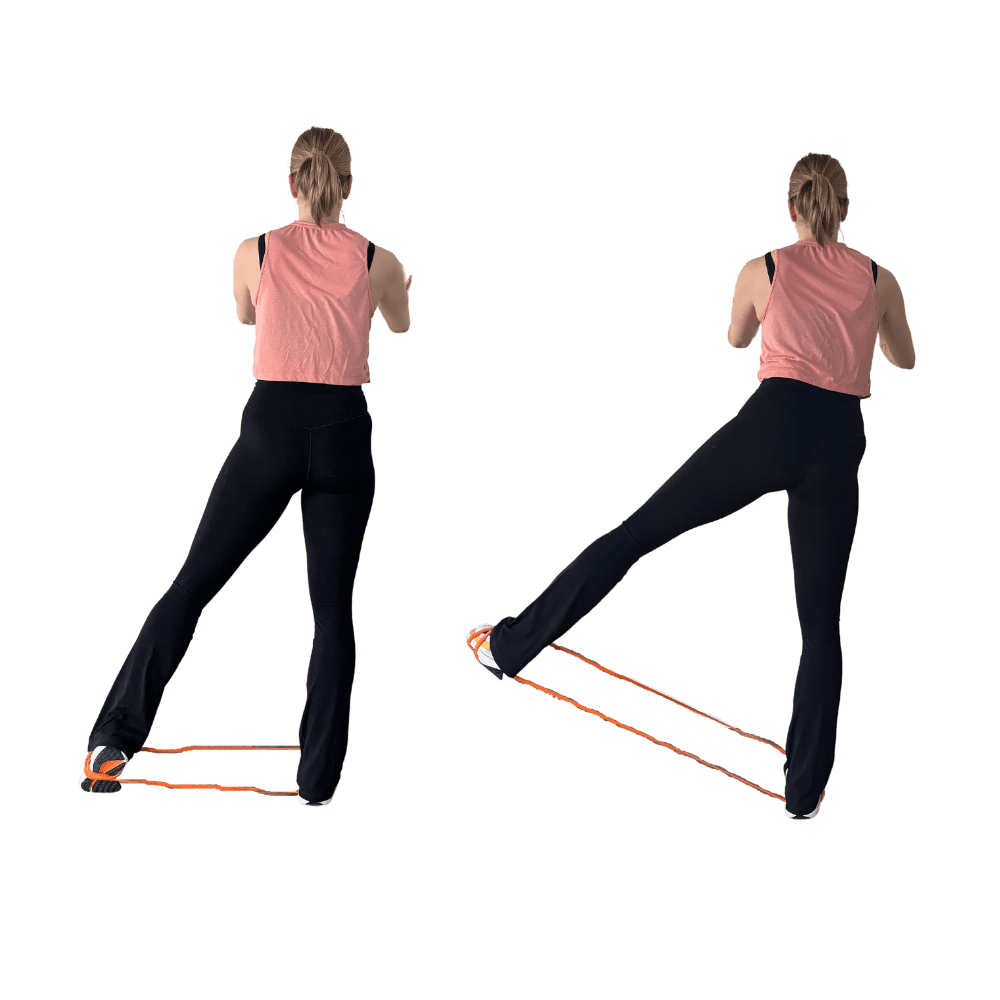
- First, secure a resistance band just above your ankles or wrap then around your feet. Stand with your feet hip-width apart, ensuring the band is taut but not overstretched.
- Lean slightly to your right, shifting your weight onto your right leg. You can hold yourself on a wall.
- Now, with controlled movement, raise your left leg to the side as high as the tension allows, keeping the rest of your body stable. Make sure your hip doesn’t shift outward.
- Pause at the apex of the movement, then slowly lower your leg back to the starting position. This constitutes one rep. Repeat the movement, aiming for consistency in form and intensity.
- Switch sides after completing your set to ensure balanced strength development across both hips.
Maintaining balance is crucial; concentrate on keeping your core tight throughout the exercise to help stabilize your body.
Additionally, make sure the band stays in place – it shouldn’t roll up or down, as this could lessen the effectiveness of the workout.
Resistance band side leg raises are not only excellent for toning leg muscles and glutes but also for improving balance and stability, making them an invaluable addition to the fitness routine of athletes and fitness enthusiasts alike.
#4 Resistance Band Kickbacks (Standing)
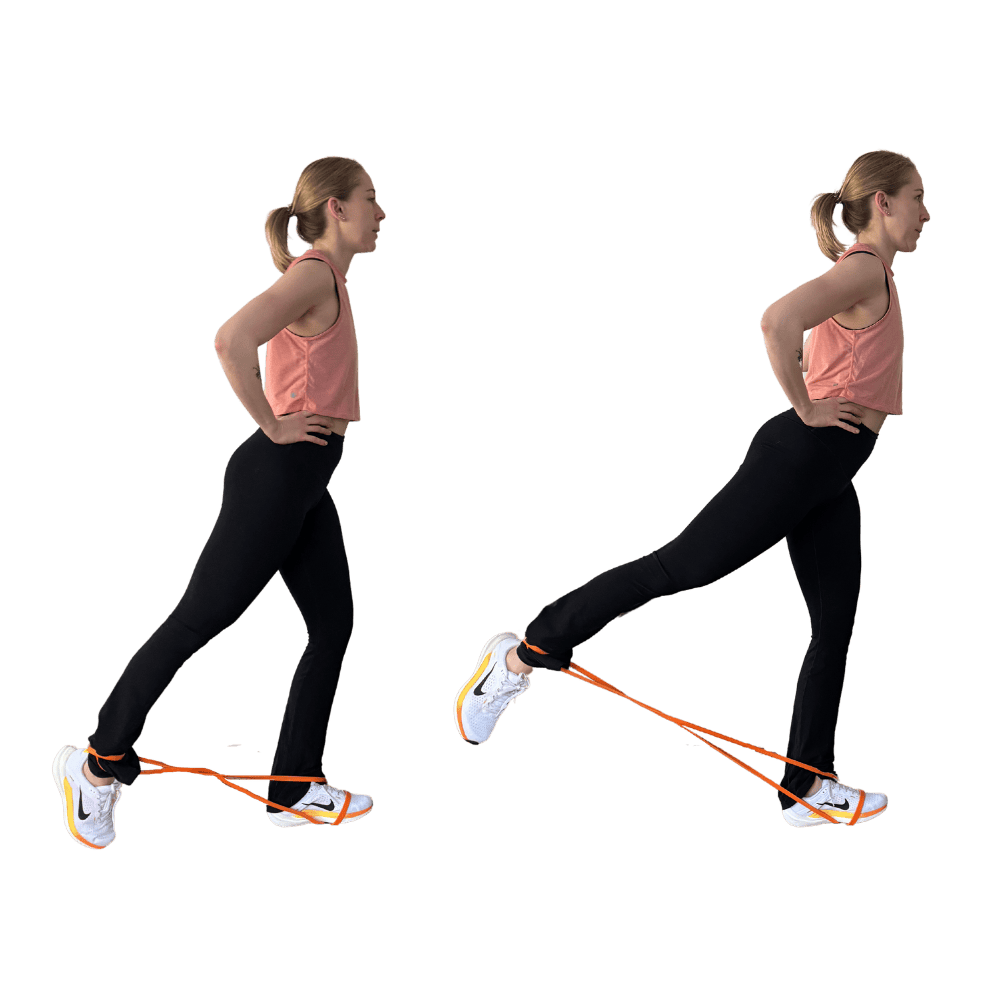
Standing resistance band kickbacks are a go-to for firing up those gluteal muscles. Kickbacks, done rightly, promise not just to tone but to strengthen, complementing other lower body workouts beautifully.
- Loop a resistance band around your ankles or feet and stand with your feet shoulder-width apart. This is your starting point.
- From here, engage your core and keep your glutes tight.
- Now, focus on isolating the glute muscles as you slowly kick one leg back. Keep your leg straight and your foot flexed.
- The resistance band should challenge you, but your movement should be controlled and deliberate. Imagine you’re pushing against a force, accentuating the contraction in your glutes.
- You can lean slightly forward and hold yourself on the wall to keep balance and focus on controlled movements.
#5 Lateral Banded Walk (Resistance Band Leg Workout)
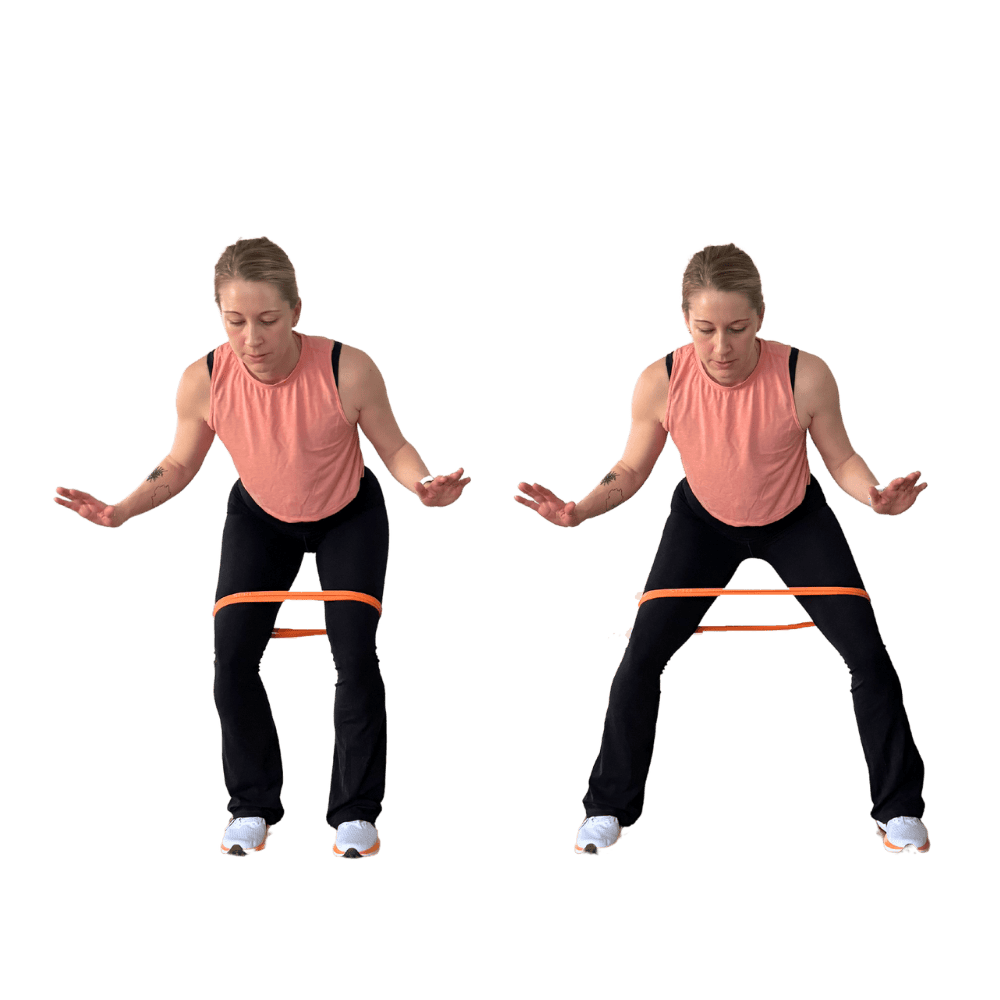
- Place your resistance band just above your knees. This placement is strategic—it zeroes in on stimulating those leg muscles, specifically targeting the often overlooked hip abductors and the powerhouse gluteal muscles.
- Now, let’s focus on the walking technique. You stand with your feet hip-width apart, creating tension on the band.
- With a slight bend in your knees, you’ll maintain a half-squat position—a critical stance for muscle engagement throughout the exercise.
- From here, while keeping the band taut, take a measured step to the side. The goal is not speed but precision and control.
- Do 4 steps to the right, then 4 steps to the left.
A common pitfall to be wary of? Not maintaining constant tension on the band or letting those knees cave in. These slip-ups can significantly reduce the effectiveness of your lower body workout.
By keeping your core engaged and ensuring you’re moving with purpose, you harness the full potential of this resistance training gem.
#6 Resistance Band Side Lying Leg Lifts
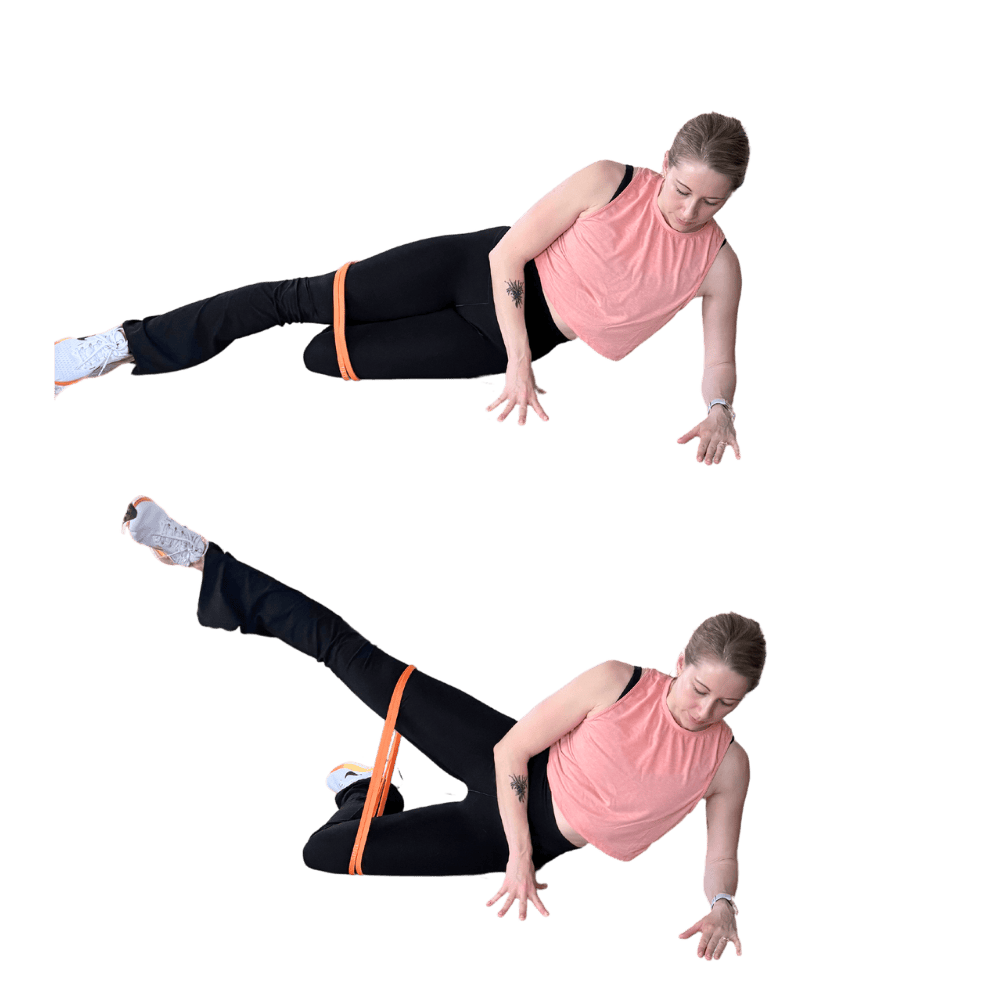
Side lying leg lifts with a resistance band are your secret weapon for targeting both the inner and outer thigh muscles, ideal for anyone committed to a comprehensive lower body workout.
- Begin this exercise by securing the band just above your knees. Find comfort on your side, keeping your lower leg angled and your elbow under your shoulder.
- Keep the top leg straight and elevate it towards the ceiling against the band’s resistance, and then lower it with control. This controlled motion is crucial for muscle recruitment and enhancing your leg muscles’ shape and strength.
To tailor the exercise to your current fitness level, simply adjust the band’s tension. Less tension suits beginners, while more tension will challenge even the most seasoned athletes.
By consistently incorporating this exercise into your fitness routine, you’re not just working towards aesthetically pleasing legs. You’re also laying down the foundation for stronger, more resilient legs and glutes.
Considering knee pain prevention, this exercise is a gentle yet effective way to build the muscles that support your knees, making it a valuable addition to your home workout arsenal.
#7 Resistance Band Lunges
If you’re seeking to escalate the intensity and challenge of your lower body workout, introducing resistance bands to your lunges can be a game-changer. This dynamic shift not only demands more from your leg muscles and gluteal muscles but ensures a deepened focus on stability and form.
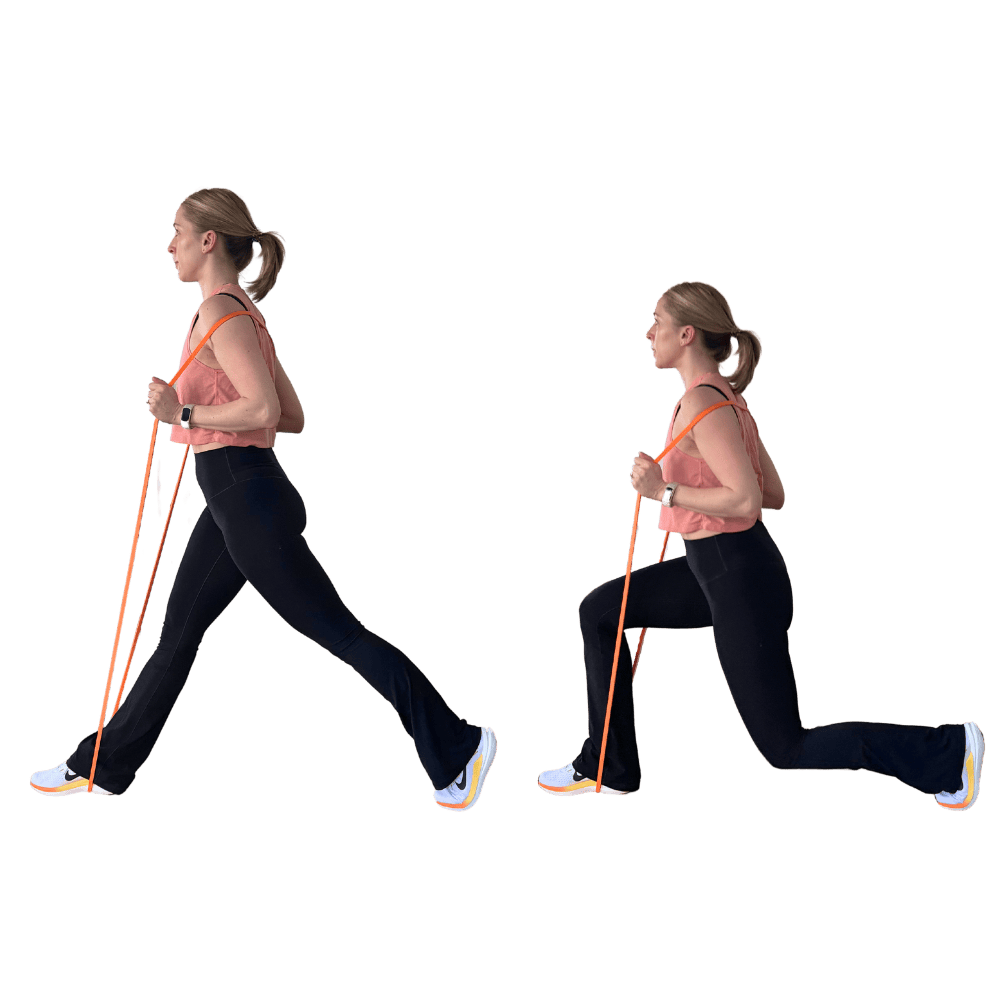
- Move into a split stance position. Wrap the resistance band around the front foot then around your shoulders. Hold it in place with your hands. Now perform the lunge.
- When we talk about ensuring proper form and knee alignment, the trick is to maintain a solid, upright posture, ensuring the knee doesn’t jut over the toes. This precision is key in reaping the benefits of resistance training without inviting injury.
Variations like the reverse lunge or lateral lunge, when done with resistance bands, introduce a multifaceted approach to muscle engagement, allowing us to tap into areas that might get less attention during traditional workouts.
These variations not only add a spice of diversity to your fitness routine but are instrumental in sculpting those legs and glutes, providing the texture and tone we often covet.
Remember, every lunge you make against the resistance of the band compounds into significant leg strength and muscle tone, making resistance band lunges an essential constituent of any efficacious leg workout.
Benefits of Using Resistance Bands for Your Leg Workout
When we talk about ramping up your lower body workout, diving into the world of resistance band exercises can be a real game-changer.
For starters, the beauty of resistance bands lies in their ability to improve muscle recruitment. With every squat, clamshell, or lateral band walk, you’re compelling your body to engage more muscle fibers, especially in those hard-to-target leg muscles and gluteal muscles.
This isn’t just a matter of working harder, but smarter, ensuring every rep counts towards building strength and muscle tone.
But there’s more to resistance bands than just muscle engagement. Their versatility caters to all fitness levels, from beginners testing the waters of resistance training to seasoned athletes looking to fine-tune their strength.
Plus, they’re a boon for home workouts, cutting down the need for bulky workout equipment. Specifically for individuals contending with knee pain, the low impact yet effective resistance offered by these fitness bands can be crucial in strengthening exercises without exacerbating the issue, ensuring a pain-free path to sturdier, more resilient legs.
Considering all these advantages, it’s clear that incorporating resistance bands into your fitness routine can significantly contribute to stronger, more toned legs and glutes, proving that sometimes, the simplest tools can lead to the most impressive gains.
Can I Build Legs with Resistance Bands?
If you’re wondering whether resistance bands can truly level up your leg day, let me put your concerns to rest.
Not only do these versatile fitness tools promise to fire up your glutes and tone your leg muscles, but they’ve also been championed by fitness experts as a formidable ally in building strength.
Think of resistance bands as not just an alternative, but a companion to traditional weightlifting. They target your lower body workout by enforcing proper form and muscle recruitment – crucial for those targeted gains.
The beauty of resistance bands lies in their ability to adapt to all fitness levels, whether you’re navigating a home workout or amplifying your gym routine.
To carve out stronger, more defined legs, consistency is your best companion. Alongside, making wise choices in your exercise selection – from resistance band squats to lateral band walks – can dramatically shape your progress.
In doing so, you’re not just working with resistance, you’re actively sculpting and fortifying your legs, proving that when used correctly, resistance bands are indeed enough to build powerful leg muscles.
Is Resistance Band Enough to Build Muscle?
You might find yourself pondering, “Can resistance bands alone pave the way to significant muscle growth?” The answer is a resounding yes, but let me guide you through how to make that happen.
First off, resistance bands are incredibly adaptable – they’re not just an add-on to your workout equipment but a powerhouse in their own right. The key is in progressively upping the resistance. Just like you would increase weights to challenge your muscles, you similarly need to escalate the resistance level of your bands.
This progression ensures your muscles are constantly being pushed to adapt, leading to growth.
Furthermore, incorporating a diverse array of resistance band exercises helps target different muscle groups effectively.
From leg workouts with resistance band squats, clamshell exercises, and glute bridges to upper body routines with bands, the variety is vast. This not only keeps your fitness journey exciting but ensures a balanced physique.
Finally, when resistance band training is brought into the fold alongside other forms of strength training, the results can be astonishing.
This isn’t about choosing resistance bands over weights or vice versa but recognizing how they complement each other. Resistance bands, with their unique tension throughout the exercise range, offer a different form of muscle engagement that weights alone can’t provide. Integrating both could be the key to unlocking your best body.
Do Resistance Bands Build Muscle Better Than Weights?
When you’re knee-deep in the journey to muscle building, you might wonder if resistance bands can stand toe-to-toe with traditional weights. It’s a valid query, considering the myriad of workout equipment flooding our fitness realms. Let’s break it down, shall we?
Resistance bands, beloved for their versatility and portability, are celebrated for providing that constant tension which is key in muscle recruitment and stimulation.
Their elastic nature allows for a full range of motion, enhancing both strength and flexibility – vital components for a well-rounded fitness routine.
On the flip side, weights, those steadfast companions in muscle building, offer a static form of resistance, allowing for targeted muscle development. They’re the go-tos for those looking to bulk up in specific areas.
Yet, it’s not a clear-cut victory for either side. The essence of resistance band exercises lies in their ability to challenge muscles differently than weights do, tapping into stabilizing muscle groups and enhancing functional movements. However, they could fall short in providing the significant load that weights offer, which is crucial for serious muscle hypertrophy.
A study compared results of strength training from weights vs. bands:
“Elastic resistance training is able to promote similar strength gains to conventional resistance training, in different population profiles and using diverse protocols.”
source
So, before you decide on resistance bands or weights, think about what you’re aiming for. If it’s enhancing muscle tone, improving flexibility, and a workout you can take anywhere, resistance bands might be your pick.
You can build strong muscle to an extend with resistance bands, as well.
For those looking to build substantial muscle mass and strength, weights could be the way to go. However even for heavy lifters, I recommend using resistance bands to increase balance and strength endurance. This is an important corner stone for weight lifting to prevent injury.
Ultimately, blending both into your fitness routine could offer you the best of both worlds.
